This post and the photos within it may contain affiliate links. If you purchase something through the link, I may receive a commission at no extra charge to you.
Cover photo by – @annlettering
In this post, we are going to talk about different types and styles of hand lettering.
It is safe to say that there are many different hand lettering styles you can create, and that basically means that your own creativity is the only limit.
The purpose of this post is to give you a sense of direction.
If you are just starting out, finding your own style can be challenging, and exploring different styles is a great way to boost your creativity.
So, what are the different types of lettering?
Here is a quick overview of the styles that we are going to cover in this post –
- Sans serif
- Serif
- Cursive / Script
- Vintage
- Gothic – Blackletter calligraphy
- Graffiti
- Creative lettering
- Other sub-lettering styles
We are going to review each style individually, their characteristics as well as examples and how to create them.
This is a beginners guide exploring the basic forms of different styles. Once you feel comfortable enough with the basics you can start to bend the rules and create your very own interpretations.
If you want to learn how to create lettering layouts with quotes and multiple words, you can check out this post here.
Without any further ado,
Let’s get started!
1. SANS SERIF
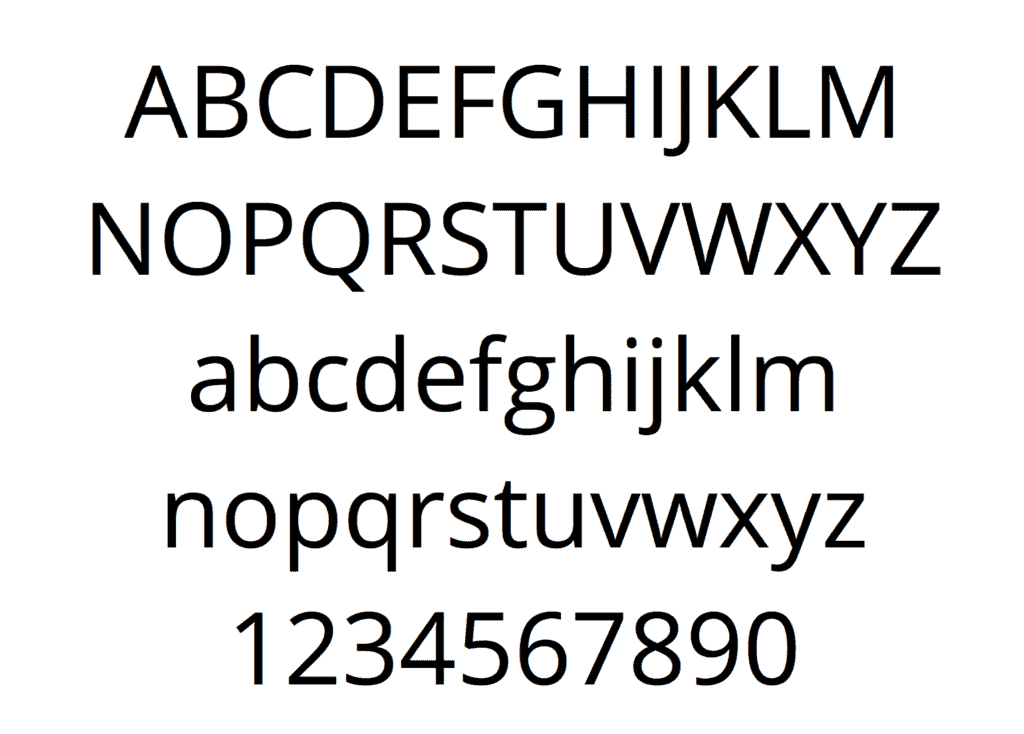
Sans serif lettering (a.k.a block letters) is one of the best starting points for lettering beginners.
This is due to their basic shapes which allows you to focus on their individual form and their relation with other letters.
The term comes from the French language where ‘’sans’’ means without – which exactly describes this style of lettering.
Although today they are mostly used as text and display for computer screens (due to the easy readability) sans serif fonts are a great addition for your lettering pieces – especially in a combination with a script style.
When creating sans serif lettering you need to pay close attention to the letterforms. (like with any other style)
It is highly important to maintain a level of consistency throughout the thickness, heights, spacing etc.
The easiest way to learn how to draw sans serif letters is with the ”wooden board” technique.
The idea behind this technique is quite simple – we just need to divide a letter in it’s most basic shapes, here is a quick example for that –
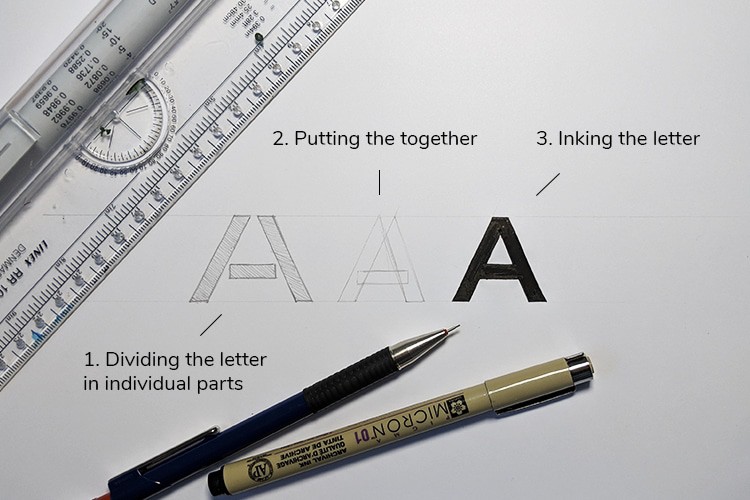
Tools used –
With the letter A we can see that it’s formed of 3 different parts, and we are combining them together.
Imagine having 3 wooden boards and stacking them together in order to create the letter A.
Here is a quick video example for the wooden board technique –
What about curved letters?
When it comes to creating curved letters such as – B, P, S, R, O, C, etc. The situation get’s a bit trickier,
but don’t worry,
I’m going to show you two different ways on how you can handle curved letters without going insane.
Method 1 for curved letters –
The first way is with the ”box” technique, and here it’s how it works.
Let’s take the letter R as an example.
We start of by drawing a basic horizontal and vertical grid of the same size.
You can do this either free hand or with a ruler.
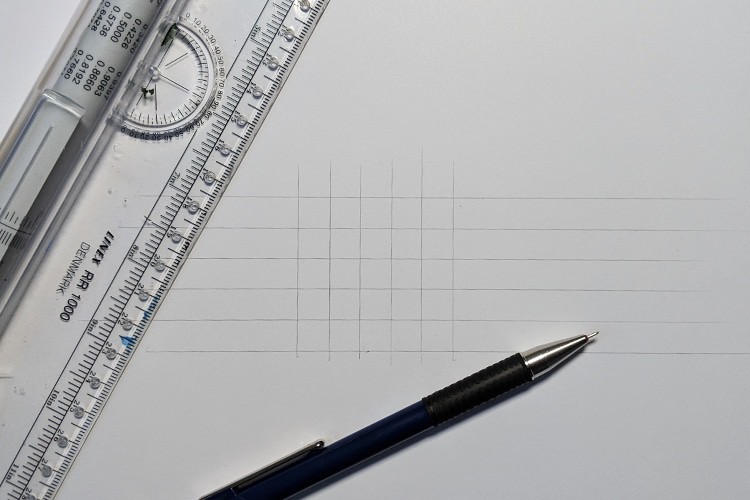
Now we just need to mark the stem (which is quite simple) as well as the bowl – and we do that by curving the sharp edges like so –
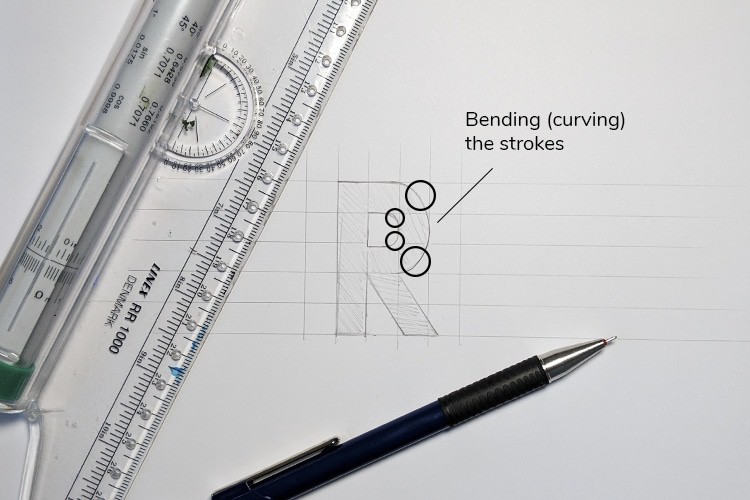
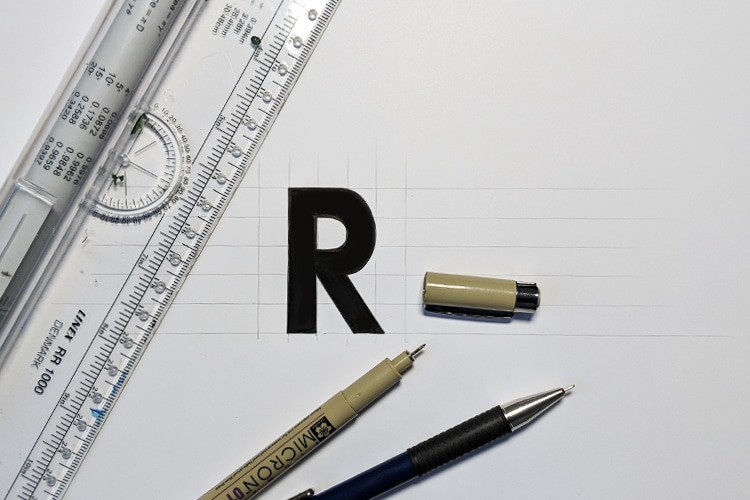
Method 2 for curved letters –
The second way to do this is by eye-balling it.
This method is a bit more difficult and it will require more practice.
Here is a quick example on how to do it –
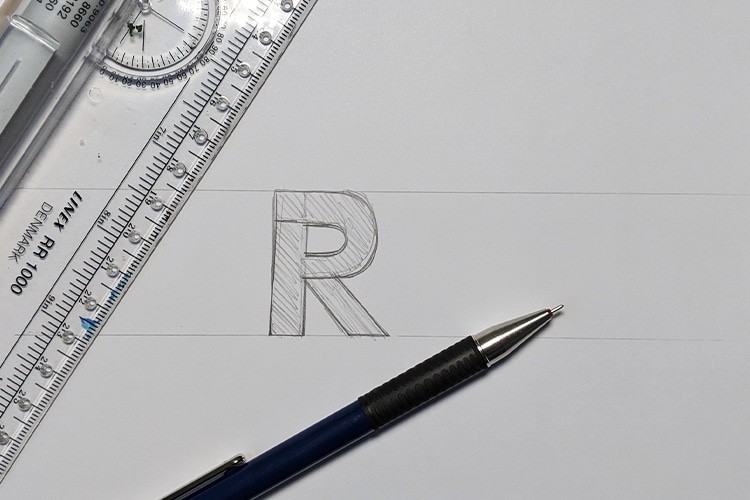
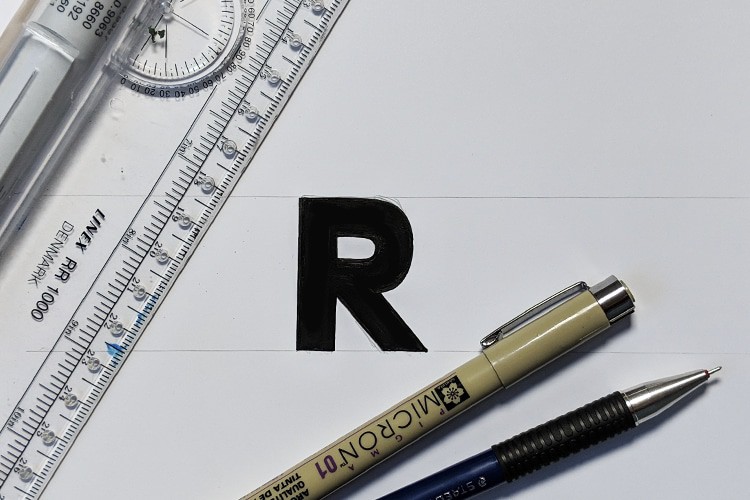
2. SERIF

Serif lettering shares the main form of the letters with sans serif letters, however, there are two main differences between sans serif and serif lettering.
- The serifs – small decorative strokes added at the end of the letterforms
- The different thickness in the strokes – not every stroke has the same thickness.
So, how to draw a serif letter?
The process is fairly similar to the creation of sans serif fonts, however, we must address these differences.
First of all,
You need to know where to add the serifs – i would highly recommend you to have an alphabet in front of yourself so you can observe and study the letterforms (remember what we mentioned earlier)
This way you will know for sure where to add them and how, instead of just guessing.
The second thing is that serif fonts don’t have the same weight on each stroke.
You can either memorize all the strokes or simply imagine how a letter is written and know that the up strokes are thin and down strokes are thick (the horizontal strokes are also thin).
Check the image below for the step-by-step process
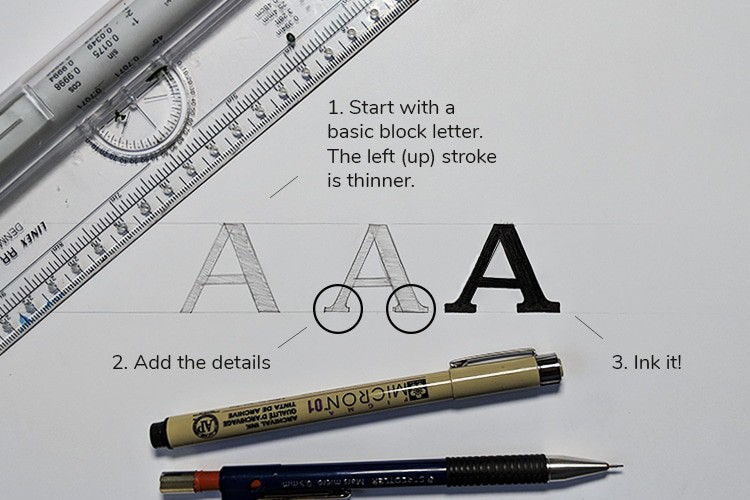
Tools used –
We basically follow the same process like with the block letters.
We use the ”wooden board” technique to divide the letters into separate shapes (remember some strokes are thinner), and then we add the serifs at the end.
3. CURSIVE
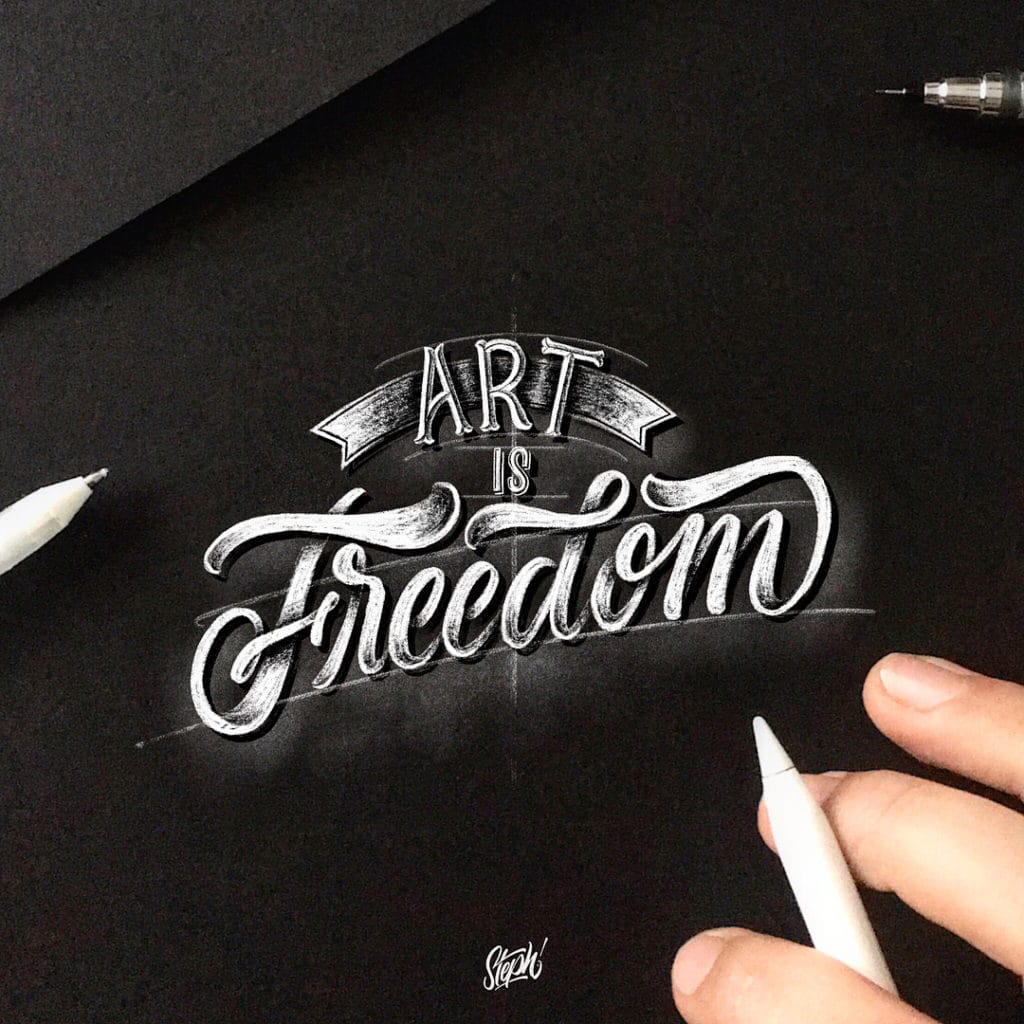
Artwork by @stephanelopes
Cursive lettering also known as script, cursive is originally a penmanship style where the characters are written together in a flowing manner.
However, when we talk about hand lettering, cursive is created in different way – since hand lettering and calligraphy are not the same thing.
Cursive in hand lettering is created by following some of the rules of calligraphy, most commonly by following the up thin and down thick rule.
The beauty of cursive hand lettering is that you are not limited by the capabilities of your pen!
What i mean by that is that with a calligraphy tool like for example a dip pen – you will be able to create only a certain stroke thickness.
With hand lettering you can create whatever shapes or forms you wish – as long as you follow the fundamentals such as consistency, balance, spacing etc
Here is a quick tutorial on how to create cursive hand lettering –
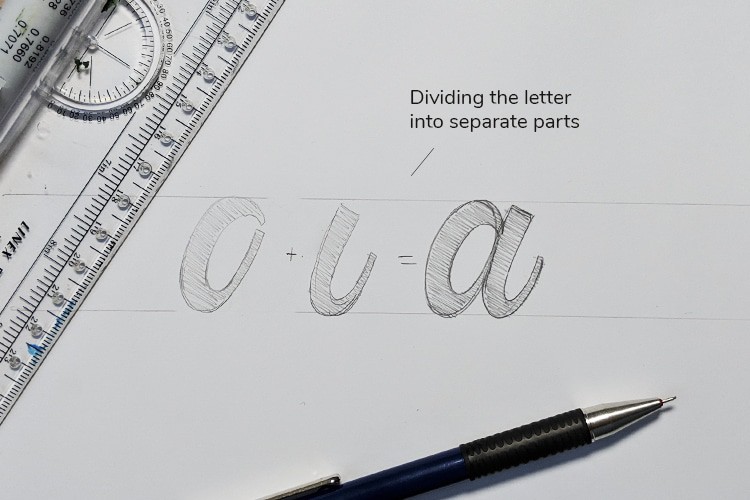
Tools used –
The idea is fairly similar to the previous styles.
We construct a letter by dividing it in separate shapes rather then drawing it as a whole.
4.VINTAGE
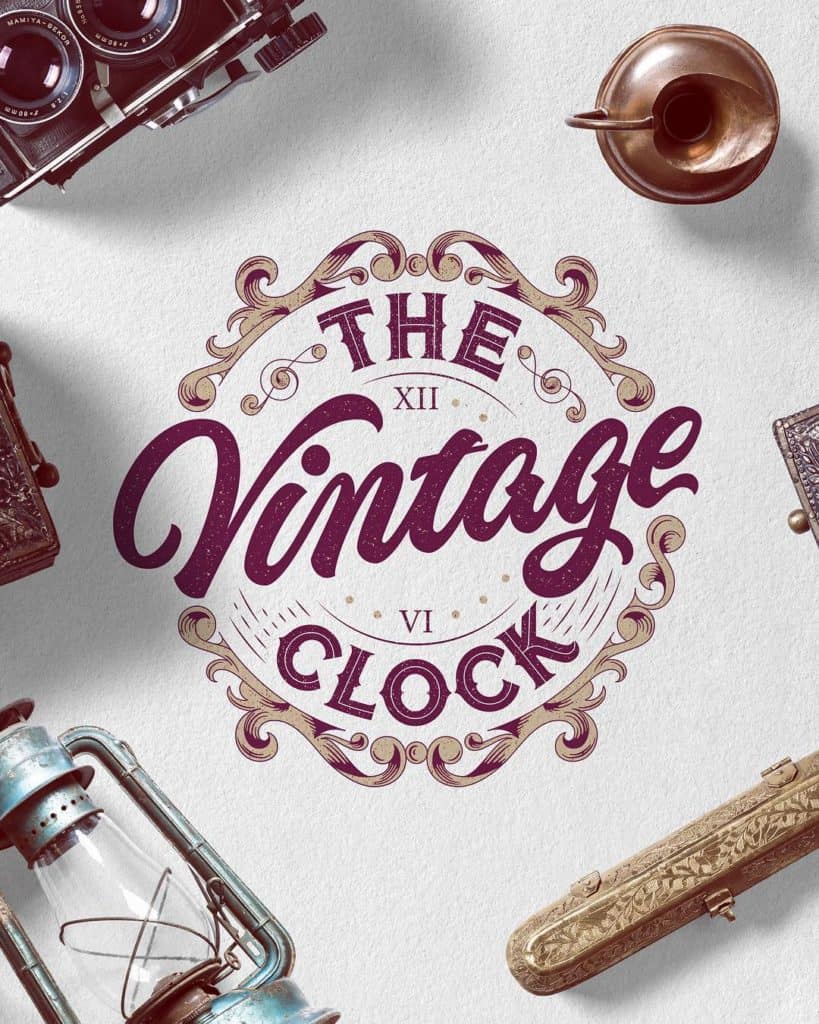
Artwork by @jimbobernaus
Vintage lettering can be characterized as a style that used to be contemporary in the 19-20th century.
It is very recognizable on a few different aspects –
- Decorations (flourishes/embellishments)
- Serifs
- Textures
- Colors
Thanks to the internet you can find thousands of examples of vintage lettering –
I highly recommend to use Pinterest as a source of inspiration.
It’s quite intriguing to observe how letterforms of the Latin alphabet developed throughout the history,
I wonder if we will have different standards 50 or even a 100 years from now.
Vintage lettering is a great way to represent something old and traditional (or if you are a hipster).
It is also getting quite trendy in the design industry as a lot of people recognize the beauty behind the vintage style.
How to create a vintage lettering style?
Step 1 –
The first thing you need to do is research!
Head over to Pinterest and do a search for ”vintage lettering”
Step 2 –
Find at least 2-3 images that you like, here is a super quick example of a mood board that I’m going to use for my example.
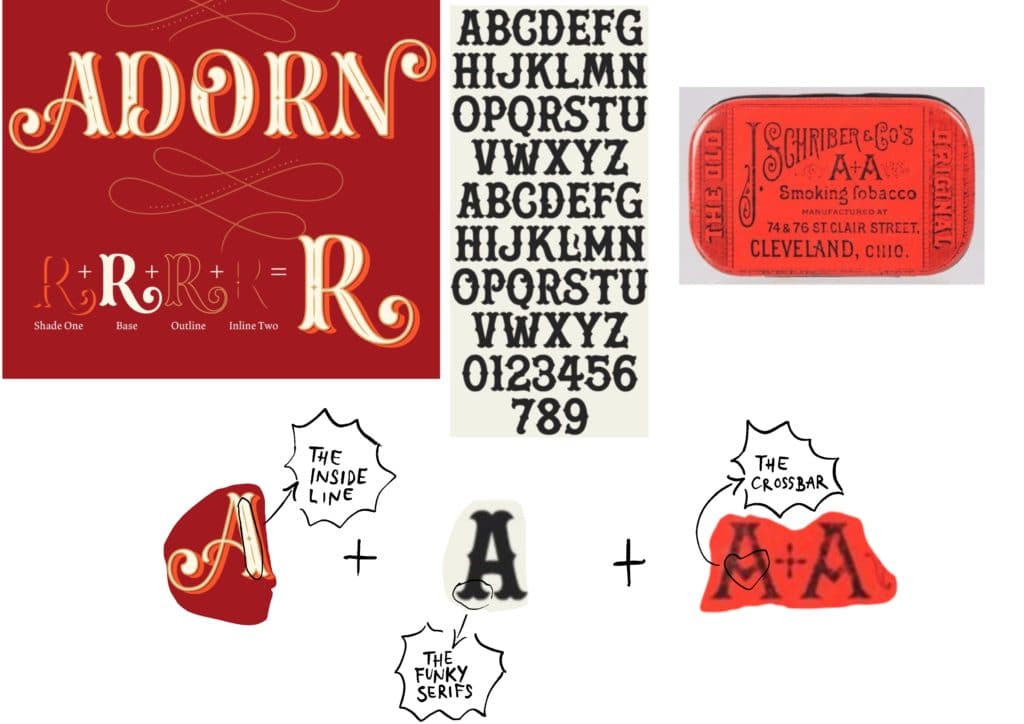
Step 3 –
I’m identifying different elements from different examples that I like, and I will use them as inspiration for my own creation.
Step 4 –
We are starting with a basic (sans serif) block letter A, that will serve as a basis upon which we will apply the previously selected elements.
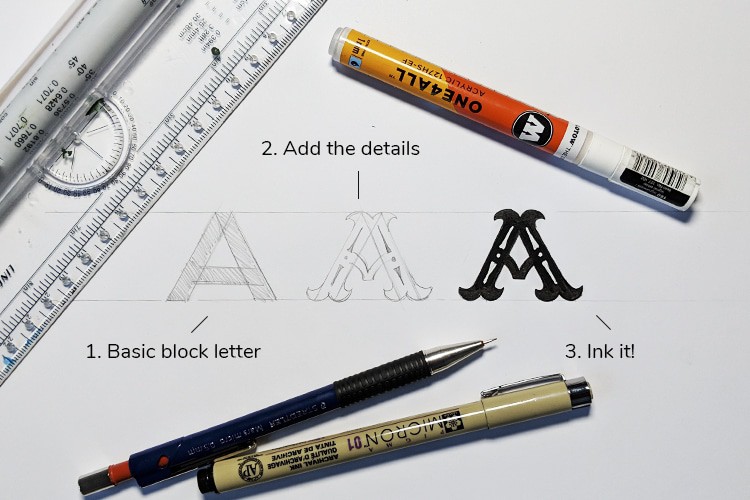
Tools used –
Adding different (pale) colors and textures is kinda difficult with pen and paper.
Don’t hesitate to transfer your work to Photoshop or Illustrator and add some final touches.
5. GOTHIC / BLACKLETTER CALLIGRAPHY
Gothic lettering is originally a calligraphy script (dating from the middle ages), however, it’s on this list for a reason.
Gothic letters have a very strong resemblance to medieval times and it can be a great choice of style if you are trying to represent something with a long tradition, old and strong.
In other words, it’s a great style if you are trying to communicate a certain message.
Also, the Gothic style it’s quite distinctive and creates a very nice contrast compared with other lettering styles.
If you want to learn more about the Gothic/Blackletter calligraphy script, I got you covered!
6. GRAFFITI
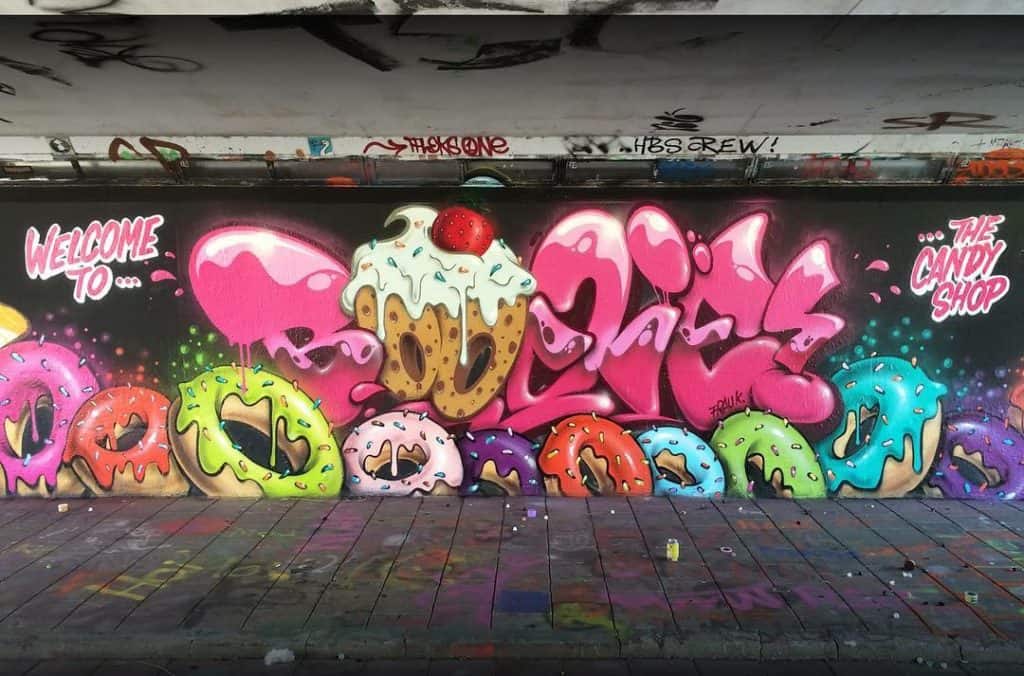
Artwork by @boogiesml
Hand lettering and graffiti are always looked as two totally different things, and (in my opinion) it’s due to the whole subculture that exists around graffiti.
But hear me out,
In it’s own essence graffiti and hand lettering are practically the same thing – if we talk about working on paper.
Graffiti is an art form that it’s mainly performed on vertical surfaces (like walls) with spray paint cans.
However, when you are drawing a graffiti sketch on paper you still use a pencil, eraser, various markers etc.
– same as with hand lettering
(that’s what i meant when i said that it’s the same thing)
Graffiti can be characterized as a more ‘’free’’ art form, meaning that there aren’t really any firm rules on how to create it – like for example blackletter or copperplate calligraphy does.
Thick, thin, round, sharp – graffiti gives you total freedom of doing whatever you want, but just keep in mind that it still needs to be well balanced, have good contrast between colors etc.
Graffiti is great when you are going for that street and urban feel in your piece.
Here is an awesome video from one of my favorite graffiti artists (Sofles) –
7. CREATIVE LETTERING
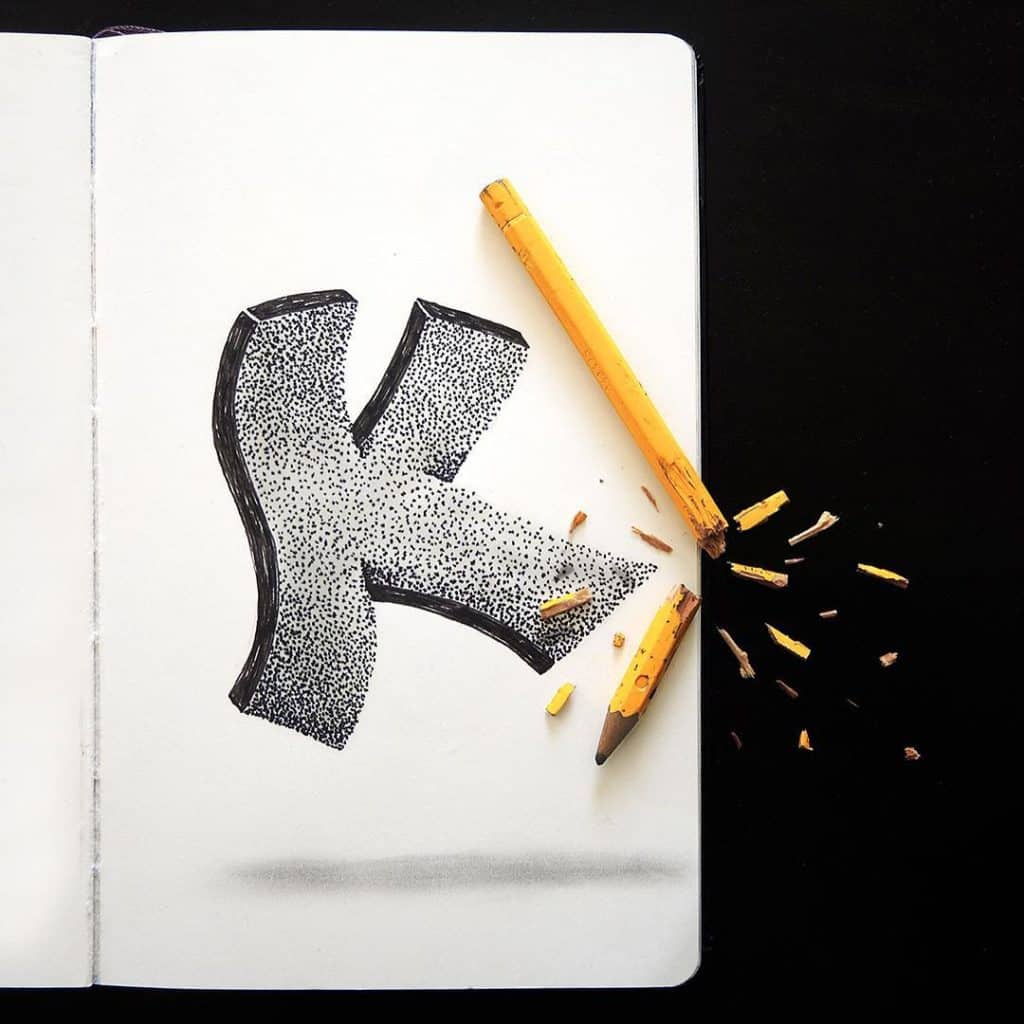
Artwork by @rylsee
This is probably one of my favorite styles!
Probably the best way to describe creative lettering it the type of lettering that incorporates some different elements besides just the letters.
This could be illustrations, textures, play on words, perspective etc.
So instead of just drawing letters in nice shapes and forms, you add illustrations, motives, and other elements to give it some context and bring it to life.
Perhaps the easiest way is to just show you what i mean exactly.
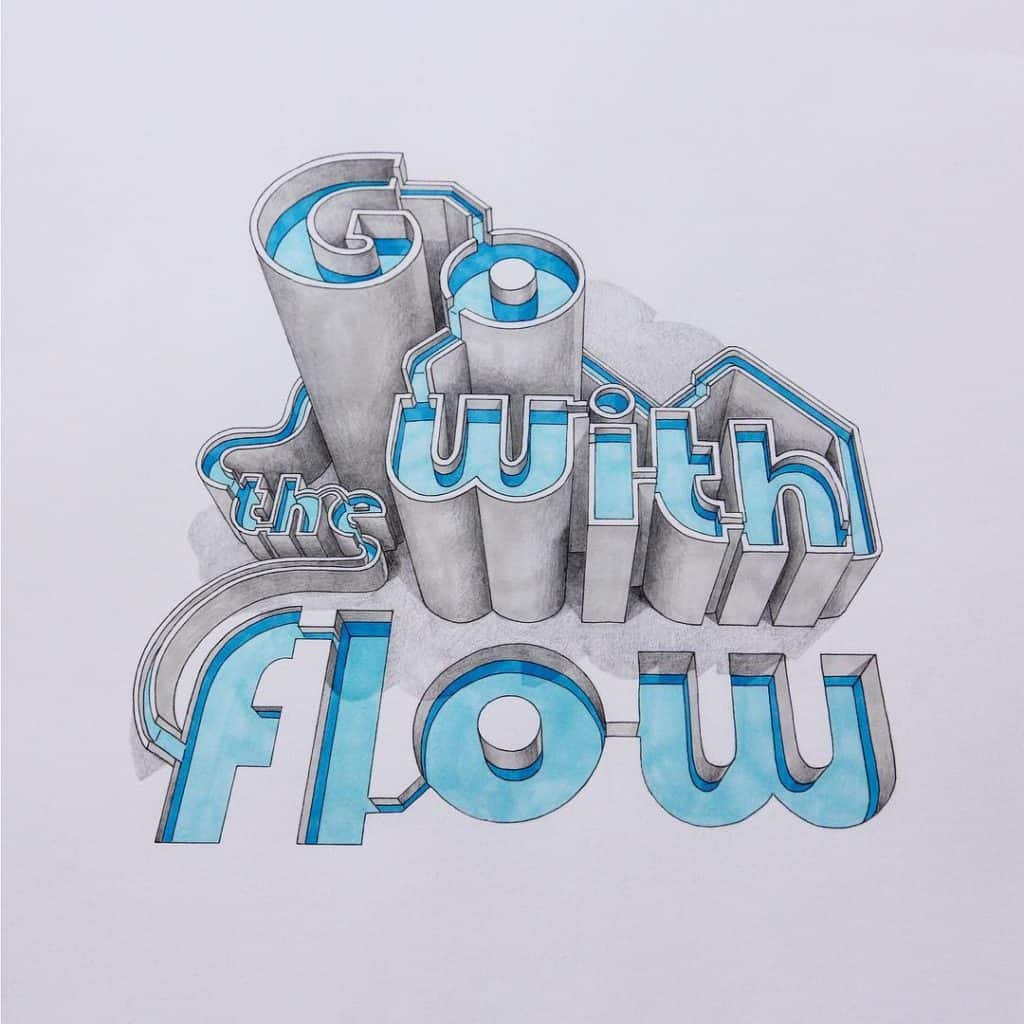
Artwork by @lexwilsontype
This may be a more complex style to pull off as it requires some illustrational experience aside from the lettering one.
Nonetheless, like with the vintage lettering style, head over to pinterest or instagram gater some inspiration and try your own work.
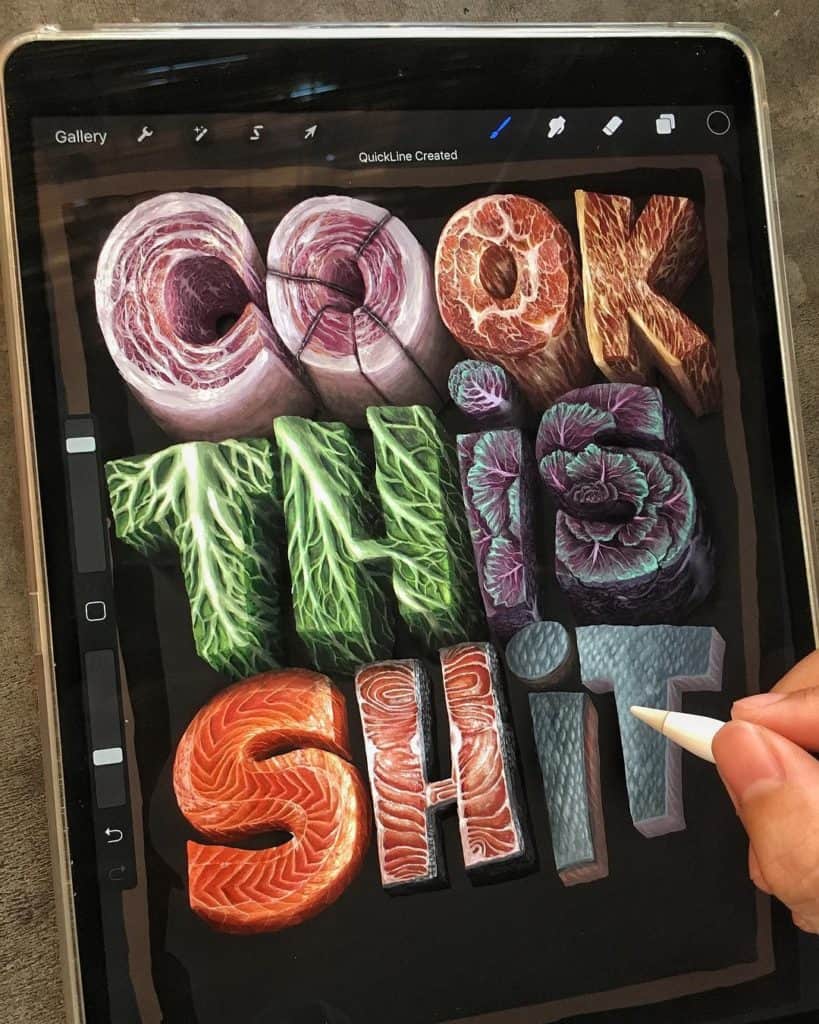
Artwork by @biksence
TO KEEP IN MIND – if you are just starting out, or if you are simply trying a technique for the first time, don’t get discouraged if you don’t like what you’ve created at first. Repeat the same artwork 5 times and compare the first and the last one –
I GUARANTEE you will notice a difference!
Here is a list of a few artists doing some amazing creative lettering –
- @rylsee
- @biksence
- @Lexwilsontype
- @mrchrista_myl
- @joey_bearbower
- @valerie_hugo
- @simonsaysletter
- @siroko_studio
8. OTHER SUB-LETTERING STYLES
Other lettering styles that perhaps are not yet that popular to have their own larger category (such as the ones mentioned above)
Lettering could be any style that your creativity can produce, i guess the only requirement is that it remains legible – otherwise, what’s the point right?
You can create a wide range of different style by –
The best way is to experiment and be curious, trial and error.
Final words about the different lettering styles
So, we talked about 8 (major) different lettering styles, and we shared some basic tips on how you can get started with them.
Finding and developing your own lettering style is a process that takes time, and it’s crucial to understand the fundamental rules.
It’s important because by bending these rules, it’s precisely how we can achieve uniqueness.
What about you? What is your favorite style?
Are you struggling to find your own style? Is there a particular area with lettering and/or calligraphy that you are struggling with or you simply can’t understand?
Check out our official Facebook group!
It’s a place where you can share your work, get constructive feedback with specific tips and resources, ask questions, meet fellow lettering & calligraphy artists and much more!
Our main goal is to help you to learn & improve.
That’s it for today, until the next time –
Stay AWESOME!
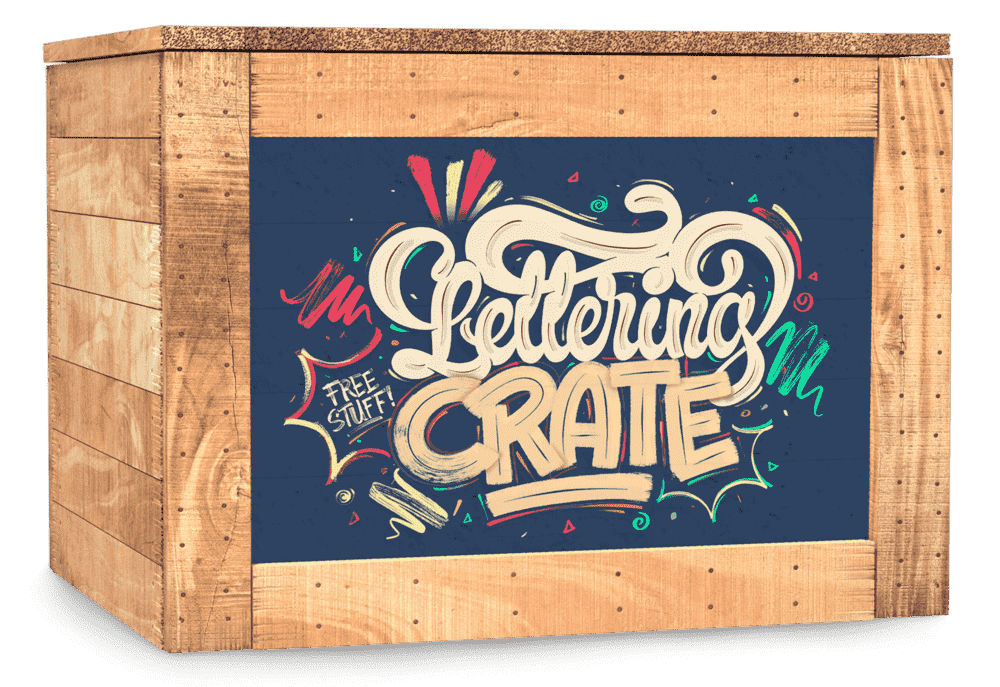
Stay updated with my tutorials and get instant access to the Lettering Crate –
A growing library of free lettering & calligraphy resources that includes –
Pin me!
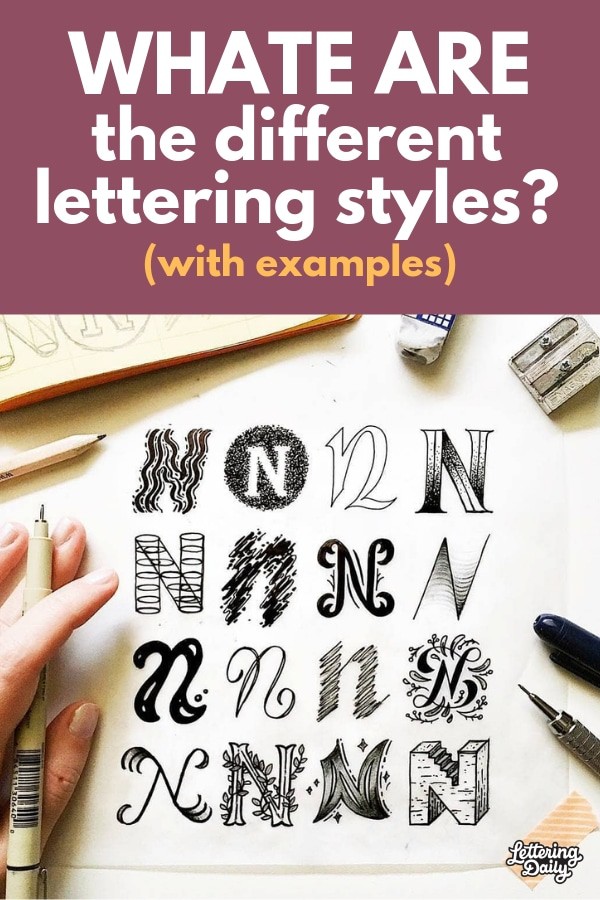
About the author

Hey, I’m Max Juric, and I’m deeply passionate about calligraphy and hand lettering.
I’ve spent years honing my skills in the art of lettering, working with hundreds of clients from all over the world on design projects such as logotypes, branding, custom lettering, murals, and more.
But my journey doesn’t end there. I’ve also dedicated myself to sharing my knowledge and expertise with others, creating a wealth of resources including tutorials, articles, and podcasts.
It’s been incredibly rewarding to see thousands of people engaging with my content each month. Knowing that I’m helping fellow enthusiasts grow and develop their skills makes me really happy.
Welcome to Lettering Daily, your hub for all things lettering and calligraphy. Whether you’re a seasoned pro or just starting out, I’m here to inspire and guide you on your lettering journey. Stick around, and let’s explore the world of letters together!

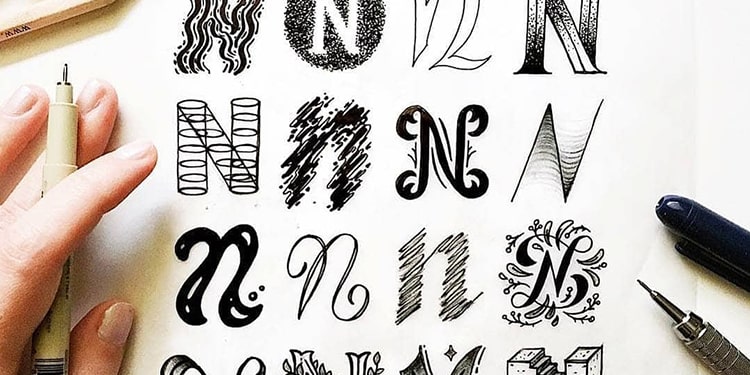
Wish to paint leather jacket with lettering and images in ‘biker ‘ style.
Have a stencil for one image but applying a stylish name and application is new to me. Any advice on paint choice and method ?
Maybe you could try with some acrylic paint?
i will use these all somtime in my life i guess
its good for grade 4 studying: )?
I dont see why not 😀
Can you do that, but with T?
Can you please elaborate? What do you mean exactly?
Does the Ray Dunn style have a special name?
Who is Ray Dunn? 😀
WAHAHHAHAHA sorry it was funny for me UwU
Do you know who he is? 😀
I think I’m Most interested in between sheriff and I gave. Any examples?
This was really informative and excellent for someone who wants to start hand lettering and doesn’t know how and where to start. Great tips and ideas to look at. Waiting for more of such articles.
Thank you for the kind words! We will make in-depth tutorials on each of the styles mentioned above as well as other step by step tutorials, so stay tuned 🙂
Good information.
What is Roman lettering??
Thank you William! Are you perhaps talking about Roman Capitals?
Check out this link here – https://en.wikipedia.org/wiki/Roman_square_capitals
Tq for the valuable information….
You are welcome!